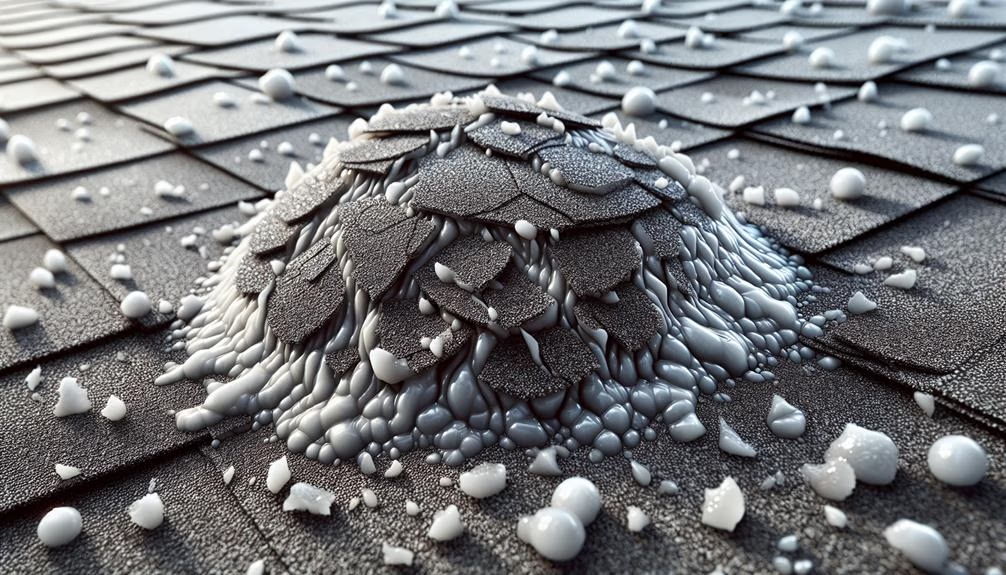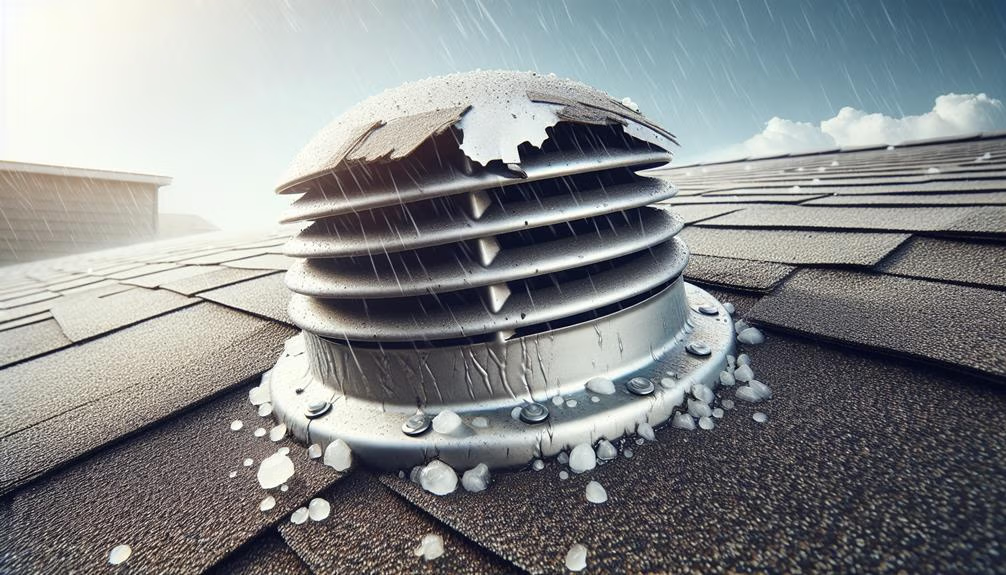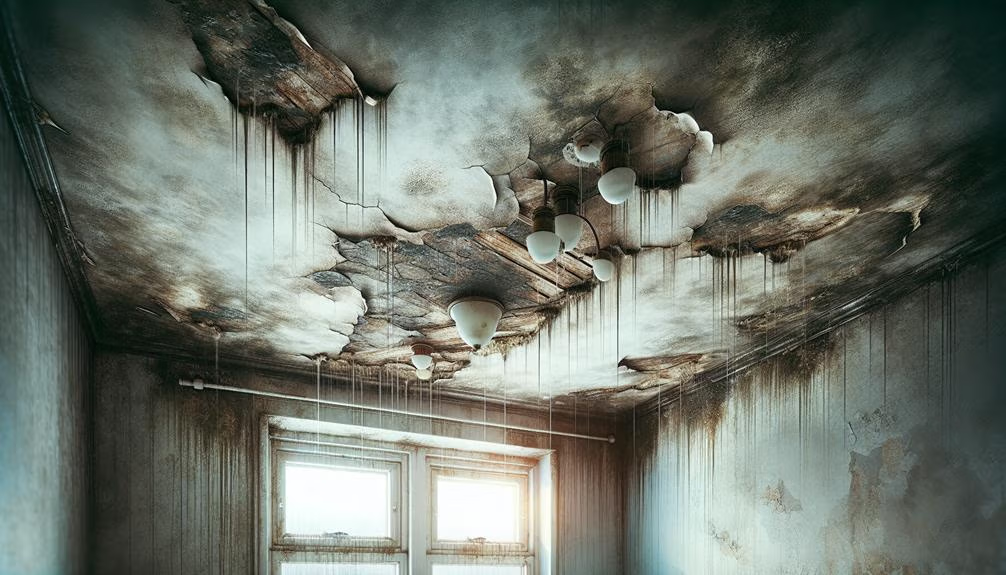To spot hail damage on your roof, begin by examining shingles for cracks, bruising, and granule loss. Inspect metal components and roof vents for dents and discoloration. Check gutters and downspouts for dents, granule build-up, and paint damage. Assess skylights for cracks, distortions, and seal leaks.
Inside your home, look for water stains on ceilings and walls, damp insulation, and signs of mold. Pay attention to any light filtering through the roof in the attic. Consider hiring a professional to ensure a thorough inspection and comprehensive report. Understanding these steps in more detail will provide a clearer picture of your roof’s condition.
Key Takeaways on How to Spot Hail Damage A Roof
- Examine shingles for cracks, dents, bruising, and granule loss.
- Inspect metal components and roof vents for signs of dents and discoloration.
- Check gutters and downspouts for granule loss, dents, and paint damage.
- Look for cracks, chips, and distortions in skylight glass and frames.
- Scrutinize ceilings and walls for water stains, damp insulation, and mold.
Inspecting Shingles for Hail Damage

Begin your inspection by closely examining the condition of the shingles, looking for any signs of cracks, bruising, or granule loss indicative of hail damage. When hail impacts shingles, it often creates discernible dents or depressions. These imperfections can compromise the integrity of the shingle, potentially leading to water infiltration and subsequent interior damage.
Focus on areas where the shingles appear discolored or exhibit a loss of granules, which are the small, coarse particles on the surface of the shingle. Granule loss exposes the underlying asphalt, making the shingle more susceptible to UV damage and accelerating its deterioration. Additionally, bruising is a common consequence of hail impact.
Run your fingers over the shingle surface to feel for soft spots or indentations that might not be immediately visible but indicate underlying damage.
Cracks in the shingles are another telltale sign. Even minor fractures can expand over time, especially under fluctuating temperatures, leading to more severe damage. Empathize with the homeowners by emphasizing the importance of addressing these issues promptly to prevent more extensive and costly repairs in the future. By meticulously inspecting each shingle, you can ensure a comprehensive assessment of hail damage.
Checking Metal Components
When inspecting your roof for hail damage, pay close attention to the metal components, such as vents, flashing, and gutters, as they can provide clear evidence of impact.
Metal parts of the roof are more prone to showing dents and dings from hailstones, making them a reliable indicator of overall damage. To accurately assess the condition of these metal components, look for the following signs:
| Component | Signs of Hail Damage |
|---|---|
| Vents | Dents, chipped paint, or cracks |
| Flashing | Warping, dents, or discoloration |
| Gutters | Dents, loosened brackets, holes |
Dents on metal vents can often be seen without the need for close inspection, and these dents may compromise the vent’s functionality. Flashing, which is crucial for preventing water penetration, can warp or discolor due to hail impact, increasing the risk of leaks. Gutters, if dented or damaged, may not properly channel water away from your home, leading to potential water damage.
Approaching this inspection with a detail-oriented mindset ensures you don’t overlook subtle signs that could indicate more extensive damage. If you find any of these indicators, it is advisable to consult a professional roofer for a thorough evaluation and necessary repairs.
Examining Roof Vents

To effectively identify hail damage on roof vents, a meticulous inspection is essential to detect any dents, chipped paint, or other signs of impact that could compromise their functionality. Roof vents play a critical role in maintaining proper ventilation in your home, and any impairment can lead to significant issues, such as moisture buildup and increased energy costs. Begin by examining the vent covers and looking for any depressions or indentations that suggest impact from hailstones.
During your inspection, consider the following:
- Dents and Dings: Look for visible dents or dings on the metal surfaces of the vents. These are common indicators of hail impact.
- Chipped or Cracked Paint: Inspect for any areas where the paint has been chipped or cracked, revealing the metal beneath. This not only affects aesthetics but can also lead to rust and further deterioration.
- Functional Integrity: Ensure that the vents are still opening and closing properly. Hail damage can distort their shape, affecting their performance.
- Surrounding Shingles: Examine the shingles around the vents for any signs of damage to provide a more comprehensive assessment of the roof’s condition.
Looking for Granule Loss
To identify granule loss, start by examining your gutters for accumulated debris, as granules often collect there following a hailstorm. Next, carefully inspect the surface of your shingles for bare spots or areas where granules appear to be missing. Such observations are crucial as granule loss can significantly impact the longevity and effectiveness of your roofing materials.
Examine Gutters for Debris
Inspecting your gutters for accumulated debris and granules is a critical step in identifying potential hail damage to your roof. When hail impacts your shingles, it can dislodge the protective granules that guard against UV rays and weather elements. These granules often end up in your gutters, signaling that your roof might have sustained damage.
To effectively examine your gutters, consider these actions:
- Safety First: Ensure you use a sturdy ladder and wear appropriate safety gear to prevent accidents while inspecting your gutters.
- Look for Granules: Check the gutters and downspouts for an unusual accumulation of granules, which are small, sand-like particles. A significant amount of granules indicates that your shingles may be compromised.
- Check for Clumps: Sometimes, granules may clump together with other debris like leaves or twigs. These clumps can block your gutters and lead to water overflow, causing further damage to your home’s exterior.
- Inspect After Storms: Always examine your gutters following severe weather events. Hail can cause immediate and noticeable granule loss, making post-storm inspections crucial for timely damage detection and repair.
Inspect Shingle Surface
A meticulous inspection of your roof’s shingle surface for granule loss is paramount in effectively identifying hail damage. Granules, the small ceramic-coated particles on asphalt shingles, serve as a critical protective layer against UV rays and weathering. When hail impacts your roof, it can dislodge these granules, leading to accelerated roof aging and potential leaks.
Begin your inspection by visually scanning the roof for bare spots where granules are missing. These areas often appear as dark patches since the underlying asphalt becomes exposed. Pay close attention to the sections of the roof that face the direction from which the hailstorm originated, as they are more likely to show signs of damage.
Next, gently run your hand over the shingle surface to feel for any rough or uneven textures. This tactile inspection can reveal granule loss that might not be immediately visible. Additionally, check the gutters and downspouts for an accumulation of granules, indicating significant damage.
Approaching this task with care and thoroughness ensures that any hail damage is promptly identified, allowing for timely repairs. Remember, addressing granule loss early can prevent more extensive and costly roof issues in the future.
Identifying Dented Gutters

Inspecting your gutters for dents is a crucial step in assessing hail damage. Focus on areas where dents are commonly found, such as the edges and corners of the gutters. By conducting a thorough visual inspection, you can identify any indentations that may compromise the functionality of your gutter system.
Visual Inspection Tips
When assessing your roof for hail damage, one of the critical areas to examine is the gutters for any dents or deformations, as these can be telltale signs of impact. Dented gutters not only indicate that hail has struck your property but also may influence the effectiveness of water drainage, potentially leading to further damage if not addressed promptly.
To conduct a thorough visual inspection, consider the following tips:
- Look for Consistency: Dents caused by hail are typically consistent in size and shape. If you observe a pattern of indentations, it is a strong indicator of hail damage.
- Check for Paint Damage: Hail impacts often chip or scratch the paint on gutters. Inspect for paint discoloration or areas where the paint has been stripped away.
- Examine Gutter Seams: Pay extra attention to the seams and joints of your gutters, as these areas are more susceptible to damage. Look for separation or visible cracks.
- Inspect Downspouts: Hail can also dent downspouts. Ensure that downspouts are checked for any signs of deformation which could impair water flow.
A meticulous inspection of your gutters can reveal significant clues about potential hail damage, allowing you to take timely action to protect your home.
Common Dents Locations
Understanding where dents are most likely to occur on your gutters can significantly streamline the inspection process and ensure no critical areas are overlooked. The most common locations for hail-induced dents are the horizontal sections and the outer edges of the gutters.
These areas often bear the brunt of hail impacts due to their exposed positioning and flat surfaces, which provide minimal deflection for falling hailstones.
Begin your inspection by examining the outer edges, particularly where gutters curve or change direction, as these points are especially vulnerable. Pay close attention to the sections beneath the roof’s overhang, where the force of hailstones can be amplified by their descent from the roof. Utilize a flashlight to enhance visibility and identify any subtle indentations or deformations in the metal.
Additionally, inspect the downspouts connected to your gutters. Dents in these vertical sections can disrupt water flow and potentially lead to blockages. Remember to also check the gutter brackets and fasteners; while less susceptible to dents, damage here can compromise the structural integrity of the entire gutter system.
Assessing Skylights
Carefully examine the skylights for any signs of cracks, chips, or other damage that may have been caused by hail impact. Skylights, being more fragile than other roofing materials, are highly susceptible to hail damage. It is crucial to inspect both the glass and the surrounding frame to ensure structural integrity and prevent potential leaks.
Here are some key points to consider:
- Glass Damage: Look for visible cracks or chips on the skylight glass. Even small cracks can expand over time, leading to more significant issues.
- Seal Integrity: Check the seals around the skylight for any signs of damage or wear. Compromised seals can lead to water infiltration, which may cause further harm to the interior.
- Frame Condition: Inspect the skylight frame for dents, bends, or other distortions. A damaged frame can hinder the skylight’s ability to remain securely fastened to the roof.
- Water Stains or Leaks: Examine the area around the skylight for any water stains or damp spots, which can indicate that hail damage has compromised the skylight’s waterproofing.
Spotting Damage Inside

After thoroughly inspecting the skylights, it is equally important to examine the interior of your home for any signs of hail damage. Begin by scrutinizing the ceilings and walls for water stains, which may indicate leaks caused by hail impacts.
Pay special attention to rooms directly beneath the roof, as these areas are most susceptible to water infiltration. Discoloration or sagging in drywall can be clear indicators of moisture intrusion.
Next, inspect the attic space, if accessible. Use a flashlight to check for damp insulation, water trails, or mold growth, as these can signify compromised roofing. Additionally, look for daylight peeking through the roof boards, which suggests potential punctures from hailstones.
Do not overlook the condition of your windows and doors. Hail impact can cause cracks or chips, leading to drafts and water leaks. Ensure that windowsills and frames are intact and free from moisture buildup.
Lastly, be mindful of any unexplained increase in your utility bills, as unseen damage can affect your home’s insulation efficiency. Addressing these signs promptly can prevent further deterioration and costly repairs. Taking these steps ensures the safety and integrity of your home following a hailstorm.
Hiring a Professional
When faced with the complexities of hail damage on your roof, enlisting the expertise of a professional roofing contractor becomes crucial to ensure a thorough and accurate assessment.
Professionals bring specialized knowledge and tools that can identify even the most inconspicuous signs of damage, which may be easily overlooked by an untrained eye. An accurate diagnosis is essential not only for immediate repairs but also for insurance claims and long-term structural integrity.
Hiring a professional offers several advantages:
- Expertise and Experience: Professional roofers have extensive experience in identifying and repairing hail damage. They understand the nuances of roof structures and materials, ensuring a comprehensive inspection and effective solutions.
- Safety: Climbing onto a roof can be hazardous, especially if the structure has been compromised by hail. Professionals are trained to navigate these risks safely, minimizing the potential for injury.
- Insurance Claims Assistance: A seasoned roofing contractor can provide detailed reports and photographic evidence, aiding you in negotiating with your insurance company to secure the coverage you deserve.
- Cost-Effectiveness: While there is an upfront cost for professional services, their thorough assessment and quality roof repairs can prevent more costly issues down the line, safeguarding your investment in your home.
Frequently Asked Questions
How Soon After a Hailstorm Should I Inspect My Roof for Damage?
It is advisable to inspect your roof for damage as soon as it is safe to do so, typically within 24 to 48 hours after a hailstorm. Prompt inspection allows for early detection of potential issues, preventing further damage from weather elements. If immediate inspection is not feasible, scheduling a professional assessment within a week is recommended to ensure the integrity of your roof and facilitate timely repairs if needed.
Can Hail Damage Affect My Home Insurance Premiums?
According to the Insurance Information Institute, approximately 6.2 million properties in the U.S. were affected by hail in 2020. Hail damage can indeed impact your home insurance premiums. Insurers may increase premiums if your home is located in a hail-prone area or if you file multiple hail damage claims. Regular inspections and timely repairs can mitigate damage and potentially help in negotiating more favorable premiums.
What Tools Do I Need to Safely Inspect My Roof for Hail Damage?
To safely inspect your roof for hail damage, you will need a ladder, safety harness, gloves, and sturdy shoes with good traction. Additionally, a flashlight can help illuminate potential damage, while chalk or a marker can be used to highlight areas of concern. It is also advisable to have a camera to document any findings for insurance purposes. Prioritize safety by ensuring all equipment is in good condition and used properly.
Are There Any Specific Weather Conditions That Increase the Likelihood of Hail Damage?
Just as a perfect storm can brew the most turbulent seas, certain weather conditions significantly elevate the risk of hail damage. Severe thunderstorms, particularly those with intense updrafts, facilitate the formation of larger hailstones.
Additionally, cold fronts and low-pressure systems often create the ideal environment for hail production. Empathetically, understanding these conditions can help homeowners take preventive measures, ensuring the safety and longevity of their roofs.
How Can I Differentiate Between Old and New Hail Damage?
Differentiating between old and new hail damage involves careful examination. New damage typically appears as sharp, distinct impact marks with minimal weathering. Such marks may still have fresh granule loss, leaving exposed areas brighter. In contrast, old damage will show signs of aging, such as rounded edges, weathered granule loss, and possible algae growth. Regular inspections can effectively aid in identifying and addressing hail damage promptly.
Conclusion
The juxtaposition of external and internal inspections reveals the complexity of identifying hail damage on a roof. By examining shingles, metal components, roof vents, granule loss, dented gutters, and skylights, one can uncover visible signs of damage.
Additionally, assessing internal damage and consulting professionals provides a comprehensive evaluation. This multifaceted approach not only ensures thoroughness but also emphasizes the importance of both visual and expert inspection to safeguard the structural integrity of a home.





